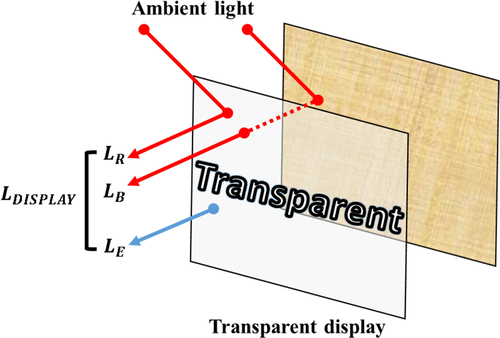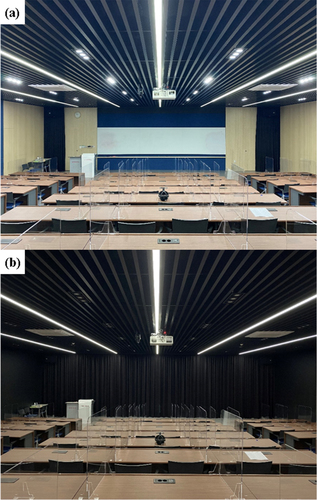 ?Mathematical formulae have been encoded as MathML and are displayed in this HTML version using MathJax in order to improve their display. Uncheck the box to turn MathJax off. This feature requires Javascript. Click on a formula to zoom.
?Mathematical formulae have been encoded as MathML and are displayed in this HTML version using MathJax in order to improve their display. Uncheck the box to turn MathJax off. This feature requires Javascript. Click on a formula to zoom.Abstract
This paper presents a physical space design method for mixed reality-based immersive environments by improving the color rendering of optically visible head-mounted displays. In OST-HMD, the phenomenon that the light of the external environment is combined with the enhanced image occurs, which reduces the visibility of the content. Moreover, previous studies to solve this problem required additional optical components or performed only simple verification. Proposed physical space was designed using black curtains, blinds, low-reflection structures, and adjustable lighting. The physical space can be adapted to the intended use of the physical space through physical transitions for multiple users without additional optics. To verify the usefulness of this environment, we measured the color gamut and intensity spectrum in three experimental environments. Also, we analyzed the factors that change the color gamut according to the components and the surrounding environment. As a result, the color gamut improved by up to 4.7 times from 19.92% to 93.53% based on the environment and improved by up to 4.1 times from 21% to 86.29% depending on the location. The experimental results revealed that the presented method could reduce the factors that degrade the color gamut within all measurement locations and significantly improve the color gamut.
Subject classification codes:
1. Introduction
ICT technology has brought about many changes in various fields due to human experience. With the development of PCs, Head-mounted display (HMD), cave automatic virtual environment (CAVE), multi-sensory devices, software, and hardware, immersive technology is rapidly developing, including virtual reality (VR), augmented reality (AR), and mixed reality (MR) technologies [Citation1, Citation2]. One of the most significant advantages of immersive technology is that it can implement an environment that cannot be applied in the real world or is difficult to implement due to cost limitations. In addition, the user’s immersion in a virtual environment is relatively high due to three-dimensional representation, interaction with virtual objects, and actual action through tracking data. Through these characteristics, a new method using immersive technology is being proposed to improve various fields’ efficiency and effectiveness.
These unique emotions vary depending on the immersive virtual environment (IVE)’s identity, friends, immersion, presence, anywhere, diversity, low latency, economy, and civilization offered [Citation3, Citation4]. Among them, immersion and presence are the most important factors in improving the immersive technology experience. Over the last few decades, immersion and presence have been defined in several variations depending on the environment in which they are used and the duration of viewing published papers [Citation5–7]. In most papers, presence is defined as emotions that users experience psychologically through responses, which are present in the IVE [Citation8–10]. Immersion is the technical quality that can convey the IVE delivered via hardware to the users’ senses [Citation11, Citation12]. Previous research confirmed that the characteristics of the hardware that makes up the IVE affect the user’s immersion, and as that element improves, their immersion improves [Citation13, Citation14]. Initially, in IVE, immersion could be affected by display parameters, visual realism, sound, haptics, virtual body representation, and body engagement providing hardware elements. However, according to the development direction of immersive technology, tracking level, stereoscopic vision, image quality, field of view, sound quality, update rate, and user perspective have recently been considered as elements that may affect immersion.
In recent years, HMD has become inexpensive, high-performing, and popularized, and users are adopting HMD in an environment that suits their intentions to implement immersive technology. VR HMD uses a see-closed HMD to allow users to immerse themselves in the virtual environment completely. The current VR HMD is used as an environment that can provide high immersion to users by significantly improving the color representation of virtual images by using high-resolution displays and thin lenses implemented with low aberrations.
In contrast, AR and MR HMD use optical see-through (OST)-HMD to interact with virtual objects against the backdrop of the real world [Citation15]. MR technology allows users to recognize various information by creating a new environment by mixing virtual content into the real world. To construct an MR world, most studies use OST-HMD utilizing projection optics. OST-HMD uses transparent waveguides, polarized beam splitter, and other transparent projection optics to deliver microdisplay-generated virtual images [Citation16, Citation17]. This method allows users to see the real world directly beyond HMD, making it more mobile based on the high degree of freedom of content, so, it is preferred over the video see-through method, which has problems with the field of view and image delay. In an MR environment, display luminance is defined differently than in traditional mobile devices. For example, by projecting a virtual image in the real world, the color accuracy is greatly affected by the illuminance in the real world compared with the conventional display. Due to this phenomenon, the rendered virtual image the user sees through the OST-HMD significantly reduces visibility, and the virtual object becomes transparent. This phenomenon negatively affects the users’ emotions toward the contents [Citation15–17].
Over the past few years, several papers have been working on improving the problem of OST-HMD visibility loss due to the effects of external illuminance. Gabbard was the first to raise this issue and empirically analyze changes due to color mixing [Citation18]. Most studies have found that the color reproduction of OST-HMDs, where there is a commonly mentioned color, is inaccurate and that the displayed color does not match the intended color when a specific color is sent from the display. These issues were then analyzed to limit the usability of OST-HMDs by causing image readability problems and color intensity and color variations that limit the design of user interface elements.
Commercialized OST-HMDs chose to reduce the illumination of the external environment in which the device is used to solve the display visibility reduction phenomenon. For example, for the Microsoft HoloLens2, they added shading to the front of the HMD, and for the Epson Moverio series, they provided a black-coated filter. This solution of changing or adding physical structures could temporarily improve display performance. However, the rather bulky OST-HMD form factor issue caused user discomfort. Also, this method has a disadvantage – switching meaningful display performance according to the usage environment is impossible. Researchers from universities and institutes have proposed various theoretical solutions. Ramos et al. proposed an algorithm for real-time color correction based on the display profile [Citation19]. They presented a middleware called Smart Color for color management of interface components and used a method to output alternate colors that best preserves the original colors we want to output from the display. As a result, the readability of the text output within the display has increased significantly. However, this method has only been demonstrated in a simulated environment and is not a solution applicable to real products as it does not use a camera to collect usage environment information for the OST-HMD.
Weiland et al. proposed a system that integrates a camera to collect information on the usage environment and corrects the display’s color [Citation20]. However, this method has the disadvantage of only being available for static systems, as it only provides corrected images for fixed positions, which is inconsistent with the intended use of OST-HMDs. Recently, Zhang et al. proposed a rendering scheme to improve the color contrast between virtual objects and the surrounding background in OST-HMD [Citation21]. This paper proposed an algorithm that can optimize color contrast enhancement from the psychophysical point of view of color perception. To validate this method and evaluate its performance, we used a commercially available OST-HMD. However, the approach is limited – no adaptive threshold corresponds to the current physical environment. Furthermore, the paper states that displaying black or dark colors is still a problem due to the hardware limitations of OST-HMD, and solving these problems is out of the scope of software-based solutions.
As a hardware solution, we used an optical component to block the illumination of the external environment and utilized a method to achieve occlusion. In the first related study, Kiyokawa et al. proposed inserting a liquid crystal display (LCD) to block light between two coupling lenses in an OST-HMD system [Citation22, Citation23].
Yamaguchi et al. proposed an integrated light field display using three microlens array layers and achieved occlusion by inserting two LCD panels in the gaps between the three lens layers [Citation24].
Krajancich et al. presented a system that produces synthetic light by masking via a single digital micromirror device (DMD) during the OST-AR video distribution process, which combines real and virtual environments. As a result, the light can be blocked on a pixel-by-pixel basis, the light emitted by the light-emitting diode (LED) can be adjusted, and hard-edge occlusion and plausible shadow can be achieved with just a single spaital light modulator (SLM) [Citation25].
Ju et al. presented an OST-HMD with a single DMD capable of occlusion expression and a polarization-based double-pass configuration. The system allows pixel-by-pixel occlusion because the single DMD performs a real-world mask and a display role for outputting virtual images over time multiplexing [Citation26].
Chae et al. presented the OST-HMD, which can express occlusion by utilizing a lens array and a photochromic plate that can change the transmittance of visible light with light close to ultraviolet. The system can leverage photochromic materials with fast response speeds to provide occlusion in real-time [Citation27].
Zhang et al. presented an OST-HMD with a double parabolic mirror structure and a single liquid crystal on silicon (LCoS) (SLM) for rendering hard-edge occlusions for wide field of view. In this system, double parabolic mirrors significantly increased the system’s numerical aperture, eliminated most optical deviations, and LCoS was used as the SLM to render hard-edge occlusion patterns [Citation28]. Most display performance improvement studies have utilized software-based compensation techniques or optics capable of hardware-based occlusion representation. However, the software-based approach has the problem of weak performance improvement and the inability to switch dynamically according to the usage environment. In addition, the hardware-based method only performs verification in a limited method. When applied to commercial products, it adds the inconvenient structure of OST-HMD, so there was a form factor problem. Another problem is that the display performance and transparency differ depending on the structure of the OST-HMD, so it must be manufactured for each device used. Furthermore, when many users utilize it simultaneously, such as in an educational space or training ground, providing improved methods tailored to the user-specific device may be challenging. Therefore, to provide many users an immersive environment for OST-HMD, it is necessary to configure a suitable physical environment. However, examples of these studies have not yet been published.
This paper proposes a method to improve display performance by adjusting the surrounding environment using OST-HMD. This method can improve significant display performance for multi-users, such as lecture halls and training grounds, without requiring additional devices or compensation matrices for OST-HMD. In addition, this method can fluidly adjust the appropriate surrounding environment according to the content provided by the OST-HMD and is expected to provide a considerable sense of immersion to the user.
Section 2 describes three parameters of MR HMD that evaluate the proposed physical space and the improvement of user immersion. Section 3 explains the components of the designed physical space and validates user immersion improvements by measuring the display’s performance characteristics at specified physical space locations. Finally, section 4 includes the study’s conclusions.
2. Configuration of physical space design
2.1. Theorical background
Mixed reality technology allows users to recognize various information by creating a new environment – mixing virtual content into the real world. Most studies use OST-HMD utilizing projection optics to construct a mixed reality world. The OST method uses transparent waveguides, polarized beam splitter, and other transparent projection optics to deliver microdisplay-generated virtual images. This method allows users to see the real world directly beyond HMD, making it more mobile based on the high degree of freedom of content. Hence, it is preferred over the video see-through method, which has problems with the field of view and image delay. In an MR environment, display luminance is defined differently than in traditional mobile devices. The total display that affects the user when viewing a virtual image via OST-HMD is the brightness due to the background of the external environment (
), the brightness from the reflection or glare effect due to the structure of the projection optical system (
). The total brightness (
) that conveys the image of the OST-HMD display can be classified as shown in Figure .
is a light that combines three types of brightness. In an environment with a general indoor illuminance or higher,
becomes the dominant light, and the visibility of the virtual image generated by
drops sharply [Citation29–32].
2.2. Implementation
We propose a physical space that can physically adjust the illumination and provide a completely immersive environment for users configured in an achromatic dark environment. We considered the following characteristics to implement the physical space: black ceiling with low reflection, dark walls and tables, black curtains, and programable lightning. Depending on the situation, the method proposed under the following conditions can be converted between a traditional environment and immersive environment using illumination and a retractable curtain. Figure shows the physical space drawing, and Table provides information on the components considered for constructing the physical space.
Figure 2. Drawing of physical space for providing immersive environment (a) Floor plan (b) Cross section.
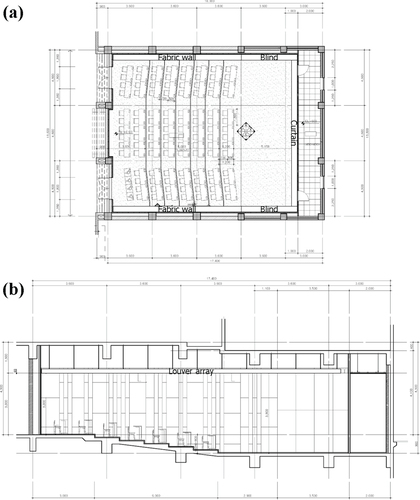
Table 1. Components and information of physical space.
Figure (a) shows that the illumination is set high for achromatic dark structures after folding all curtains and blinds in a traditional physical space environment. As illustrated in Figure (b), when the user operates the switch to convert to the immersive environment, the curtain and blind with a high absorption coefficient spread, the light generated by the lighting is absorbed, and the front curtain expresses black. Furthermore, the light visor blocks light simultaneously.
2.3. Experimental setup
In Figure , we set up three presets to design the optimized physical space for implementing an immersive environment. Figure (a) shows the environmental conditions for a general lecture using a whiteboard or beam projector. In this situation, all the curtains and blinds in the space are spread out, and we set the illuminance in the physical space to 600lux in line with the Korea’s industrial standard. Figure (b) demonstrates the environmental conditions partially adjusted to 300lux for improved immersion in the immersive environment. In this situation, all the curtains and blinds in the physical space are spread out, and the lights in front of the physical space are turned off to reduce the degradation of the OST-HMD visibility caused by the . Figure (c) shows the preset with all curtains and blinds deployed and all lights adjusted to implement a fully immersive environment. In this state, front lighting and all position lighting were set to a minimum to reduce OST-HMD degradation caused by
. The lighting in the physical space is set to 50 lux, the minimum illuminance for the simultaneous localization and mapping (SLAM) of Microsoft HoloLens2, a typical OST-HMD, and the grayscale camera for spatial mapping to work. The illumination of the physical space was measured in the center. All environment illuminance fluctuation was kept within ±1%.
Figure 4. Experimental presets to adjust light condition (a) Traditional environment (b) Partial adjustment environment (c) Full adjustment environment.
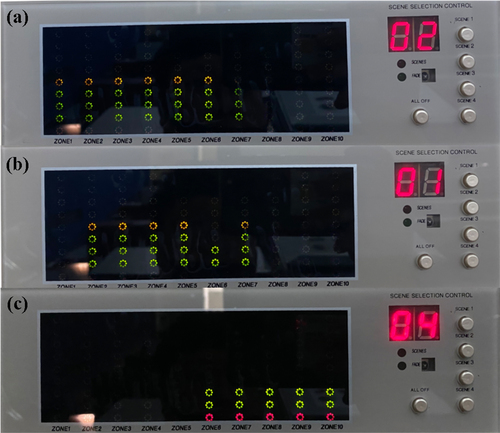
To verify the proposed method, we measured the display performance of OST-HMD in each experimental environment using a spectrometer (GL Spectis 1.0 Touch) connected with an optical probe (GL Opti Probe 5.0 luminance). Display performance such as CIE 1931 color chart, intensity spectrum, and color coordinate were extracted using GL Spectrosoft. Numerical calculations and graphical representations were performed using Matlab. Also, we measured the display performance by dividing the data into three halves horizontally and two halves vertically, totaling six areas. This experiment’s result confirms that all users in the physical space experience the same increased immersion.
3. Measurement result
We displayed the red (R, G, B = 255, 0, 0), green (R, G, B = 0, 255, 0), and blue (R, G, B = 0, 0, 255) colors in the OST-HMD. The display performance was obtained using the spectrometer. Figure (a)–(f) shows the CIE 1931-based color charts for each experimental environment according to location. Table shows the color coordinates specific to each experimental environment and the color gamut for NTSC 72% contrast as a function of location. All color gamut values are rounded to two decimal places. The traditional environment, except the central back location, had the lowest display performance. In this environment, the average color gamut was 26.02%, the highest color gamut was 43.62% at the central back location, and the lowest color gamut was 19.92% at the front left location. The partial adjustment environment significantly improved over the traditional environment in all environments, except the central back location.
Figure 5. Comparison of CIE 1931 color chart of OST-HMD systems according to environment state and location (a) Front, Left; (b) Front, Center; (c) Front, Right; (d) Back, Left; (e) Back, Center; (f) Back, Right, Intensity Spectrum of the OST-HMD systems according to environment state and location (g) Front, Left; (h) Front, Center; (i) Front, Right; (j) Back, Left; (k) Back, Center; (l) Back, Right.
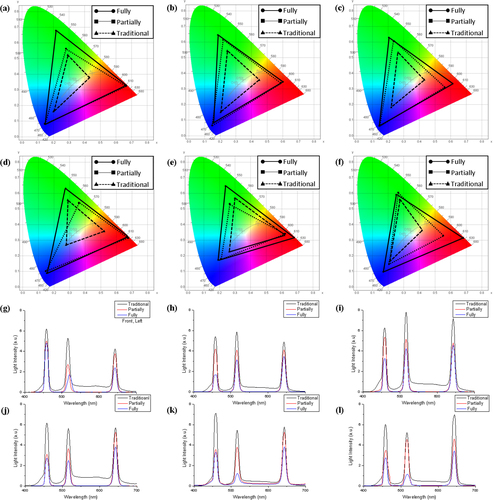
Table 2. Optical characteristics of the OST-HMD systems according to environment state and location.
In this environment, the average color gamut was 57.41%, the highest color gamut was 70.3% at the central front location, and the lowest color gamut was 36.7% at the back, center location. Finally, the full adjustment environment showed the best display performance anywhere. In this environment, the average color gamut was 78.53%, the highest color gamut was 93.53% at the front left location, and the lowest color gamut was 70.26% at the central back location. Converting from the traditional environment to the partially adjusted environment yielded an average of 2.44 times improvement in color representation. In particular, in terms of color gamut, the back location improved 1.85 times. On the other hand, the front location showed a significant difference of 3.03 times, while the center location improved 1.68 times, the left location improved 3.05 times, and the right location was 2.61 times. When converting from the traditional environment to the full adjustment environment, the color gamut improved by an average of 3.33 times. In particular, in terms of color gamut, the back location improved 2.85 times, while the front location improved 3.74 times, showing a significant difference. The center location improved 2.18 times, the left location improved 4.14 times, and the right location 3.57 times. It showed a significant difference, such as double improvement. Finally, when converting from the partial adjustment environment to the full adjustment environment, the color representation improved by an average of 1.42 times. Particularly, regarding color gamut, the back location improved 1.63 times, while the front location improved 1.22, 1.36 times at the left, and 1.41 times at the right locations, it showed a constant improvement value overall. When converting to the full adjustment environment to provide the best immersive feeling, the amount of change in the average color gamut due to the horizontal location is 2.06 times at the center location, 4.1 times at the left location, and 3.56 times at the right location. Also, even with the color gamut in the full adjustment environment, it was confirmed that it was 73.59% at the center location, slightly lower than 86.19% at the left location and 75.82% at the right location. The change due to the vertical location was 2.55 times on average at the back location, slightly different from the 3.62 times at the front location. In addition, even in the case of the color gamut in the full adjustment environment, it was confirmed that it was 74.29% at the back location, slightly lower than 82.77% at the front location. In the intensity spectrum of visible wavelength, the values of red, green, and blue light intensity were the highest in the traditional environment at all locations. Moreover, in the traditional environment, the peak wavelength region of each color image and the light intensity of the visible wavelength due to external light are measured similarly. In contrast, the partial adjustment and full adjustment environments measure the dominant light intensity in the peak wavelength region of each color image. Furthermore, the light intensity in the partial adjustment environment was calculated as the same or higher than the intensity in the full adjustment environment.
4. Discussion
The experimental results confirmed that the display performance of OST-HMD, including color gamut, changes rapidly according to the external environment. Of the three experimental environments configured in the experiment, the one with the lowest display performance was the traditional environment. There are two reasons color gamut declines in traditional environments. The first cause is , caused by lighting and objects in the real world in the usage environment, and the second is
, where light generated from lighting enters the transparent optics of the OST-HMD through direct refraction or reflection. In the traditional environment with
and
mentioned above, it is confirmed through the intensity spectrum that not only the intensity of the peak wavelength regions of red, green, and blue but also the intensity of all visible light regions due to D65 white-based white light illumination are combined. We confirmed through the color coordinates and color chart that the color accuracy of the projected image on the OST-HMD deteriorates due to the light synthesis phenomenon when the entire visible spectrum region has a light intensity in this way.
The most significant physical environment change when converting from the traditional environment to partial or full adjustment was spreading the front and side curtains and blinds, which could affect the user’s field of vision. Such environmental change is replaced by dark environment as if it functions as a light visor in front of the output part of the OST-HMD image. Also, the that structures in the real world can cause has decreased sharply. As a result, only the red, green, and blue wavelength regions were measured dominantly on the intensity spectrum. Moreover, the color chart and color coordinates confirmed that the color accuracy and gamut were definitely improved.
In addition, all lighting is adjusted when converted to full adjustment, the lighting in front of the physical space is extinguished and similarly minimized to the incoming refracted or reflected by the projection optics of the OST-HMD. In this situation, the light intensity value decreased compared to the partial adjustment environment, but it was confirmed that the color gamut was partially improved at all locations. Through the experimental results, we confirmed that the most effective way to show display performance above a certain level is to adjust for areas that may affect the user’s field of view.
Also, we confirmed that the display performance, including the color gamut of the OST-HMD, can be measured differently depending on the measurement location. The center location is where the light generated from all the lighting in the external environment can reach, so it is an environment where relatively large values are generated. In contrast, the left and right locations either have black curtains and blinds on the adjacent wall or a dark achromatic fabric wall to reduce the influence of lighting in the external environment. Therefore, it is less affected by
and
. For this reason, we confirmed through the color coordinates and color chart that the improvement in color gamut was the least at the center location.
Also, although the improvement tendency of the display between the front location and the back location is the same, there are two main reasons for the difference in the improvement figures. The first cause is the step between the back location and the front location, and the second cause is the difference between the projected image of the OST-HMD and the real-world information that enters the user’s viewing angle depending on the location. The step between the front and back locations in the experimental environment is 600 mm, the relatively higher intensity of illumination present in the external environment at the back location. As a result, the color gamut of is relatively reduced at the back location. Furthermore, in the back location, the black ceiling comes together from the user’s field of vision, and
has less influence than the front location. Considering both causes, we found that the back location has a higher color representation in the traditional environment than the front location but less improvement when converting between physical environments.
5. Limitation and future work
This paper does not require additional devices or reward matrices for OST-HMD and focuses on providing significant display performance improvements for multi-users such as classrooms or training halls. We acknowledge the limitations of some experiments before completing them.
First, constructing the space proposed in this paper requires much cost. We have spent about $200,000 to construct a physical space that can transform illumination and surroundings. We carried out a large-scale construction and needed new materials such as lighting, tile walls, and fabric to design this space. When developed to leverage a software-based compensation matrix, only maintenance costs are incurred for algorithm updates; only hardware-based, optically coated filters are provided, or LCD production costs are incurred. The cost of these studies is considerably less than the cost of implementing the space proposed in this paper. However, traditional research methods require continuous maintenance to keep the performance of the display constant. In particular, optical components produced by hardware-based studies require periodic maintenance or replacement to maintain the same performance, and new optical components must be produced for the display if a new OST-HMD is released. In contrast, the method proposed in this paper has the advantage of being semi-permanent once designed. Furthermore, even with the release of the new OST-HMD, we can improve the display’s performance by resetting the optimized environment for that display at no additional cost.
Second, a more accurate lighting design is required to achieve the same display performance improvement in all spaces. The space designed in this paper provides a different illuminance in all spaces due to gaps between lights and different steps. This means that some differences in display performance may occur depending on the user’s location wearing the OST-HMD in the space. To compensate for this, in the future, we will implement it as a virtual model in modeling software based on the drawing and then conduct a lighting analysis simulation to verify that it has uniform illuminance in all spaces.
6. Conclusion
We proposed a design method for physical space that can improve the color representation of OST-HMD to improve the user’s immersion in the physical space for an MR-based immersive environment. A designed physical space with a low-reflectance black ceiling, retractable black curtains and blinds, and programed lighting were used to verify the validity of the proposed method and reduce the factors that degrade the color representation of the OST-HMD. To confirm the performance improvement of OST-HMD, we divided the three experimental environments and six measurement locations and measured the color gamut, color coordinate, and intensity spectrum. In this experiment, the color gamut improved by up to 4.7 times from 19.92% to 93.53% depending on the environment and up to 4.1 times by location from 21% to 86.29%. Through these results, we reduced factors that reduce color gamut in all measurement locations and significantly improved the color gamut. We even analyzed the factors that change color gamut depending on the components and surrounding environment. This method can be physically converted to achieve the appropriate environment for physical space usage and has significantly higher color rendition for multi-users without additional optical elements to improve the performance of OST-HMD. In the future, we plan to focus on improving users’ sense of immersion and influencing their emotions and satisfaction by developing the color gamut.
Disclosure statement
No potential conflict of interest was reported by the author(s).
Additional information
Notes on contributors

Jihyung Kim
Jihyung Kim obtained his Ph.D. (Electrical Engineering) from Pohang University of Science and Technology (POSTECH), the Republic of Korea, in 2022. He is currently a Postdoctoral Researcher at POSTECH Future IT Innovation Laboratory. His research interests include the design of virtual and augmented reality, telepresence, near-eye display, multi-sensory device, immersive environments, and computers and education.

Jonghyeon Ka
Jonghyeon Ka obtained his B.S. (Electrical engineering) from Pohang University of Science and Technology (POSTECH) in Pohang, the Republic of Korea in 2020. He obtained his M.S. (Electrical engineering) from Pohang University of Science and Technology (POSTECH) in Pohang, the Republic of Korea in 2022. He is currently pursuing a Doctor’s degree (Electrical engineering) at Pohang University of Science and Technology (POSTECH) in Pohang, Republic of Korea. His research interests include the design of head mounted display (HMD), and immersive environments.

Ju Hong Park
Ju Hong Park obtained his Ph.D. (Architecture) from Massachusetts Institute of Technology (MIT) in 2015, He was an assistant professor at University of Miami and is currently an associate professor at Pohang University of Science and Technology (POSTECH) in Pohang, Republic of Korea.
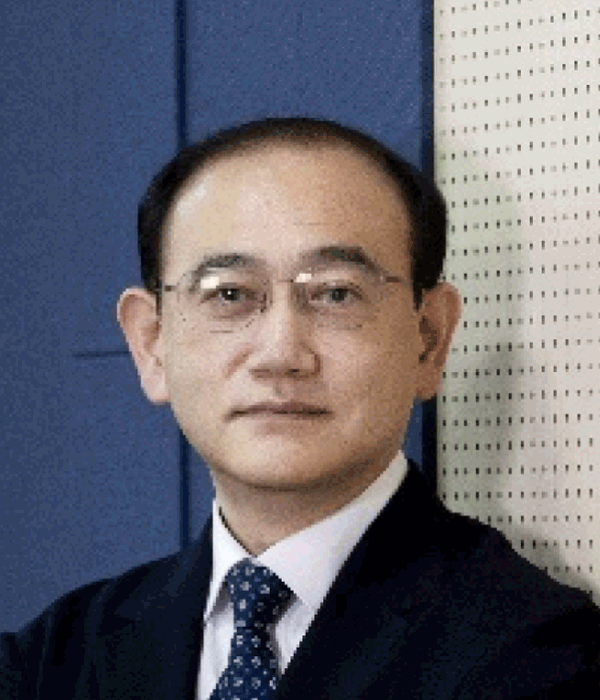
Wooksung Kim
Wooksung Kim obtained his B.S. and M.Sc. (Physics) from Korea University, the Republic of Korea, in 1989 and 1991 respectively, and his Ph.D. (Engineering Science) from the University of Oxford in 2010. He was a research engineer at LG Display for 26 years and is currently an associate professor at Pohang University of Science and Technology (POSTECH) in Pohang, Korea. His research interests include traditional displays, near-eye displays for AR and VR, and future displays. He also has research activities related to wave array technologies, such as LC-based antennas, metasurface applications, and ultrasound arrays for various applications.
References
- J. Kim, S.W. Oh, J. Choi, S. Park, and W. Kim, Optical see-through head-mounted display including transmittance-variable display for high visibility, J. Inf. Disp. 23 (2), 121–127 (2022).
- J. Kim, S. Park, and W. Kim, A structure of optical see-through head mounted display, 2020 International Conference on Electronics, Information, and Communication (ICEIC), IEEE, 2020. p. 1–3.
- Y. Wang, Z. Su, N. Zhang, R. Xing, D. Liu, T.H. Luan, and X. Shen, A survey on metaverse: Fundamentals, security, and privacy, IEEE Communications Surveys & Tutorials, 2022.
- J. Han, J. Heo, and E. You, Analysis of metaverse platform as a new play culture: Focusing on roblox and ZEPETO, CEUR Workshop Proceedings 3026, 27–36, 2021.
- J.J. Cummings, and J.N. Bailenson, How Immersive Is Enough? A Meta-Analysis of the Effect of Immersive Technology on User Presence, Media Psychology 19 (2), 272–309 (2016).
- B. Laha, K. Sensharma, J.D. Schiffbauer, and D.A. Bowman, Effects of Immersion on Visual Analysis of Volume Data, IEEE Trans. Visual. Comput. Graphics 18 (4), 597–606 (2012).
- Y.F. Wang, S. Petrina, and F. Feng, VILLAGE—Virtual Immersive Language Learning and Gaming Environment: Immersion and Presence, Br. J. Educ. Technol. 48 (2), 431–450 (2017).
- M. Slater, V. Linakis, M. Usoh, and R. Kooper, Immersion, presence and performance in virtual environments: An experiment with tri-dimensional chess, Proceedings of the ACM Symposium on Virtual Reality Software and Technology, 163–172, 1996.
- M. Slater, and S. Wilbur, A Framework for Immersive Virtual Environments (FIVE): Speculations on the Role of Presence in Virtual Environments, Presence: Teleoperators Virtual Environ. 6 (6), 603–616 (1997).
- M. Slater, A note on presence terminology, Presence connect 3 (3), 1–5 (2003).
- Agrewal, S., Simon, A.M.D., Bech, S., Bærentsen, K.B. and Forchammer, S., Defining immersion: Literature review and implications for research on audiovisual experiences, J. Audio Eng. Soc. 68 (6), 404–417 (2020).
- I. Uspenski, and J. Guga, Embodying Metaverse as artificial life: At the intersection of media and 4E cognition theories, Filozofija i drustvo 33 (2), 326–345 (2022).
- J. Keil, D. Edler, T. Schmitt, and F. Dickmann, Creating Immersive Virtual Environments Based on Open Geospatial Data and Game Engines, KN – J. Cartography Geog. Inf. 71 (1), 53–65 (2021).
- T. Rose, C.S. Nam, and K.B. Chen, Immersion of virtual reality for rehabilitation - Review, Appl. Ergon. 69, 153–161 (2018).
- Y. Itoh, T. Langlotz, J. Sutton, and A. Plopski, Towards Indistinguishable Augmented Reality, ACM Comput. Surv. 54 (6), 1–36 (2022).
- H.J. Jang, J.Y. Lee, G.W. Baek, J. Kwak, and J.H. Park, Progress in the development of the display performance of AR, VR, QLED and OLED devices in recent years, J. Inf. Disp. 23 (1), 1–17 (2022).
- H.J. Jang, J.Y. Lee, J. Kwak, D. Lee, J.H. Park, B. Lee, and Y.Y. Noh, Progress of display performances: AR, VR, QLED, OLED, and TFT, J. Inf. Disp. 20 (1), 1–8 (2019).
- J.L. Gabbard, J.E. Swan, J. Zedlitz, and W.W. Winchester, More than meets the eye: An engineering study to empirically examine the blending of real and virtual color spaces, 2010 IEEE Virtual Reality Conference (VR), 79–86, 2010.
- J.D. Hincapié-Ramos, L. Ivanchuk, S.K. Sridharan, and P. Irani, SmartColor: Real-time color correction and contrast for optical see-through head-mounted displays, 2014 IEEE International Symposium on Mixed and Augmented Reality (ISMAR), 187–194, 2014.
- C. Weiland, A.K. Braun, and W. Heiden, Colorimetric and photometric compensation for op- tical see-through displays, International Conference on Universal Access in Human- Computer Interaction, 603–612, 2009.
- Y. Zhang, R. Wang, Y. Peng, W. Hua, and H. Bao, Color Contrast Enhanced Rendering for Optical See-Through Head-Mounted Displays, IEEE Trans. Visual. Comput. Graphics 28 (12), 4490–4502 (2022).
- K. Kiyokawa, M. Billinghurst, B. Campbell, and E. Woods, An occlusion capable optical see-through head mount display for supporting co-located collaboration, The Second IEEE and ACM International Symposium on Mixed and Augmented Reality, 2003. Proceedings, 133–141, 2003.
- K. Kiyokawa, Y. Kurata, and H. Ohno, An optical see-through display for mutual occlusion of real and virtual environments, Proceedings IEEE and ACM International Symposium on Augmented Reality (ISAR 2000), 60–67, 2000.
- Y. Yamaguchi, and Y. Takaki, See-through integral imaging display with background occlusion capability, Appl. Optics 55 (3), A144–149 (2016).
- B. Krajancich, N. Padmanaban, and G. Wetzstein, Factored Occlusion: Single Spatial Light Modulator Occlusion-capable Optical See-through Augmented Reality Display, IEEE Trans. Visual. Comput. Graphics 26 (5), 1871–1879 (2020).
- Y.G. Ju, M.H. Choi, P. Liu, B. Hellman, T.L. Lee, Y. Takashima, and J.H. Park, Occlusion-capable optical-see-through near-eye display using a single digital micromirror device, Opt. Lett. 45 (13), 3361–3364 (2020).
- M. Chae, K. Bang, Y. Jo, C. Yoo, and B. Lee, Occlusion-capable see-through display without the screen-door effect using a photochromic mask, Opt. Lett. 46 (18), 4554–4557 (2021).
- Y. Zhang, X. Hu, K. Kiyokawa, N. Isoyama, N. Sakata, and H. Hua, Optical see-through augmented reality displays with wide field of view and hard-edge occlusion by using paired conical reflectors, Opt. Lett. 46 (17), 4208–4211 (2021).
- A. Ghosh, I. Khayrullin, Q. Wang, F. Vazan, T. Ali, I. Wacyk, K. Tice, and L. Sziklas, 3.1: Invited Paper: OLED Micro-displays for VR/AR Applications, SID International Symposium Digest of Technical Papers, 2019; 50(S1):26–27.
- H. Chen, G. Tan, and S.T. Wu, 74-1: Invited Paper: Can LCDs Outperform OLED Displays in Ambient Contrast Ratio?, SID International Symposium Digest of Technical Papers, 2018; 49(1):981–984.
- X. Mou, and J. Wang, 38-3: Evaluating Augmented Reality (AR) Eyewear Display Under Ambient Environment, SID International Symposium Digest of technical papers, 2019.
- Kim JS, Lee SW. Study on how to improve visibility of transparent display for augmented reality under various environment conditions. Opt. Express. 2020;28(2):2060–2069.

